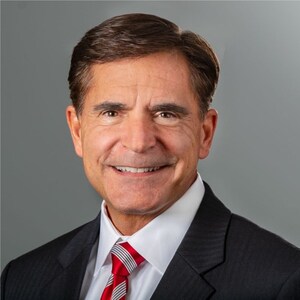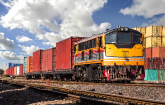Greenbrier Announces Orders for 7,000 New Railcars Valued at over $700 Million
~ Value of orders received in fiscal 2014 reaches $1.7 billion
~~ Continued strength in intermodal and energy markets lead the way
~~ Orders for tank cars exceed 2,300 units
LAKE OSWEGO, Ore., May 21, 2014 /PRNewswire/ -- The Greenbrier Companies, Inc. [NYSE:GBX] announced today that it received new orders in April and May for 7,000 railcar units valued at more than $700 million. Orders announced today comprise a broad range of railcar types including a recent award for more than 1,700 intermodal platforms. Other orders include nearly 2,500 small cube covered hoppers and more than 2,300 tank cars primarily used in the energy sector. Continued strength in automotive markets resulted in orders for 400 automotive-related products in North America and Europe.
The orders announced today are in addition to the 3,100 units valued at approximately $265 million received in March 2014 and first reported in Greenbrier's press release dated April 3, 2014. Since the start of the Company's fiscal third quarter in March, Greenbrier has received orders for more than 10,000 railcars valued at nearly $1 billion. Since September 1, 2013, the beginning of the Company's fiscal year, Greenbrier has received orders for more than 18,400 railcars in North America and Europe valued at almost $1.7 billion.
Accelerating Intermodal Loadings and Record Grain Harvest
"As we anticipated earlier this year, increases in rail loadings across multiple car types, coupled with reductions in velocity are driving demand for many of our car types, including intermodal platforms," William A. Furman, Chairman and CEO said. "Reduced railway speeds for most trains carrying crude oil continue to affect velocity across the entire rail network."
Intermodal car loadings are up more than 5% compared to the same period in 2013 as intermodal shipments by rail have surpassed pre-recession levels and continue to increase. Greenbrier also continues to benefit from a strong automotive-related products market with its comprehensive product line, as the aging fleet of automotive rail carriers has led to an active railcar replacement cycle.
Energy Markets Remain Robust
Shipments of petroleum and petroleum products, including crude by rail, have grown year to date by 6.6% compared to the same period in 2013 continuing to drive demand for tank cars. Tank car sales for agricultural products, like vegetable oil, have also been a recent area of strength with Greenbrier receiving orders for 200 units. Newly developed techniques for energy extraction by hydraulic fracking require more sand per well. As a result, car loadings for crushed stone, sand & gravel are up by nearly 7% compared to similar 2013 loadings driven largely by the growth in frac sand.
"The strength of the energy renaissance in North America continues unabated. As new energy exploration fields are activated, demand for frac sand has grown robustly," Furman continued. "Greenbrier is benefitting from this phenomenon by receiving substantial orders for its small cube covered hopper cars."
"We were also pleased to receive orders more than for 2,100 tank cars for transporting crude oil, despite lingering regulatory uncertainty on the prescribed safety design features for these cars. The specification for these current tank car orders require that these cars will meet or exceed the highest safety standard currently approved for operation on the North America rail network—the CPC-1232 tank car design standard. Greenbrier continues to press regulators and policymakers in the U.S. and Canada to adopt safer standards for railcars carrying crude oil that exceed the CPC-1232 standard. The standards that we support are consistent with our Tank Car of the Future, a new tank car design which includes a thicker hull, high-flow pressure relief valves, head shields, top fittings protection, and thermal protection. Additionally we are offering retrofit alternatives for the most recently built CPC-1232 tank cars, with features that will reduce the likelihood of tank cars releasing contents in derailments. Our approach to tank car safety advances both public safety and environmental protection, strengthens the North American tank car fleet and permits safer operations at any speed. We are pleased with recent actions by Canadian regulators and expect the U.S. and Canadian government will complete the ongoing regulatory process related to tank cars soon. We are committed to assisting our customers through this time of regulatory transition to help them achieve vital safety objectives while also protecting their railcar investment," Furman concluded.
Certain orders in this release are subject to customary documentation and completion of terms.
About Greenbrier
Greenbrier (www.gbrx.com), headquartered in Lake Oswego, Oregon, is a leading supplier of transportation equipment and services to the railroad industry. Greenbrier builds new railroad freight cars in its four manufacturing facilities in the U.S. and Mexico and marine barges at its U.S. facility. It also repairs and refurbishes freight cars and provides wheels and railcar parts at 37 locations across North America. Greenbrier builds new railroad freight cars and refurbishes freight cars for the European market through both its operations in Poland and various subcontractor facilities throughout Europe. Greenbrier owns approximately 8,800 railcars, and performs management services for approximately 234,000 railcars.
"SAFE HARBOR" STATEMENT UNDER THE PRIVATE SECURITIES LITIGATION REFORM ACT OF 1995: This press release may contain forward-looking statements, including statements regarding expected new railcar production volumes and schedules, expected customer demand for the Company's products and services, plans to increase manufacturing capacity, restructuring plans, new railcar delivery volumes and schedules, growth in demand for the Company's railcar services and parts business, and the Company's strategic initiatives and future financial performance. Greenbrier uses words such as "anticipates," "believes," "forecast," "potential," "goal," "contemplates," "expects," "intends," "initiatives," "targets," "plans," "projects," "hopes," "seeks," "estimates," "could," "would," "will," "may," "can," "designed to," "foreseeable future" and similar expressions to identify forward-looking statements. These forward-looking statements are not guarantees of future performance and are subject to certain risks and uncertainties that could cause actual results to differ materially from in the results contemplated by the forward-looking statements. Factors that might cause such a difference include, but are not limited to, reported backlog is not indicative of our financial results; turmoil in the credit markets and financial services industry; high levels of indebtedness and compliance with the terms of our indebtedness; write-downs of goodwill, intangibles and other assets in future periods; sufficient availability of borrowing capacity; fluctuations in demand for newly manufactured railcars or failure to obtain orders as anticipated in developing forecasts; loss of one or more significant customers; customer payment defaults or related issues; actual future costs and the availability of materials and a trained workforce; failure to design or manufacture new products or technologies or to achieve certification or market acceptance of new products or technologies; steel or specialty component price fluctuations and availability and scrap surcharges; changes in product mix and the mix between segments; labor disputes, energy shortages or operating difficulties that might disrupt manufacturing operations or the flow of cargo; production difficulties and product delivery delays as a result of, among other matters, changing technologies, production of new railcar types, or non-performance of subcontractors or suppliers; ability to obtain suitable contracts for the sale of leased equipment and risks related to car hire and residual values; difficulties associated with governmental regulation, including environmental liabilities; integration of current or future acquisitions; succession planning; all as may be discussed in more detail under the headings "Risk Factors" and "Forward Looking Statements" in our Annual Report on Form 10-K for the fiscal year ended August 31, 2013, and our other reports on file with the Securities and Exchange Commission. Readers are cautioned not to place undue reliance on these forward-looking statements, which reflect management's opinions only as of the date hereof. Except as otherwise required by law, we do not assume any obligation to update any forward-looking statements.
SOURCE The Greenbrier Companies, Inc. (GBX)
WANT YOUR COMPANY'S NEWS FEATURED ON PRNEWSWIRE.COM?
Newsrooms &
Influencers
Digital Media
Outlets
Journalists
Opted In




Share this article